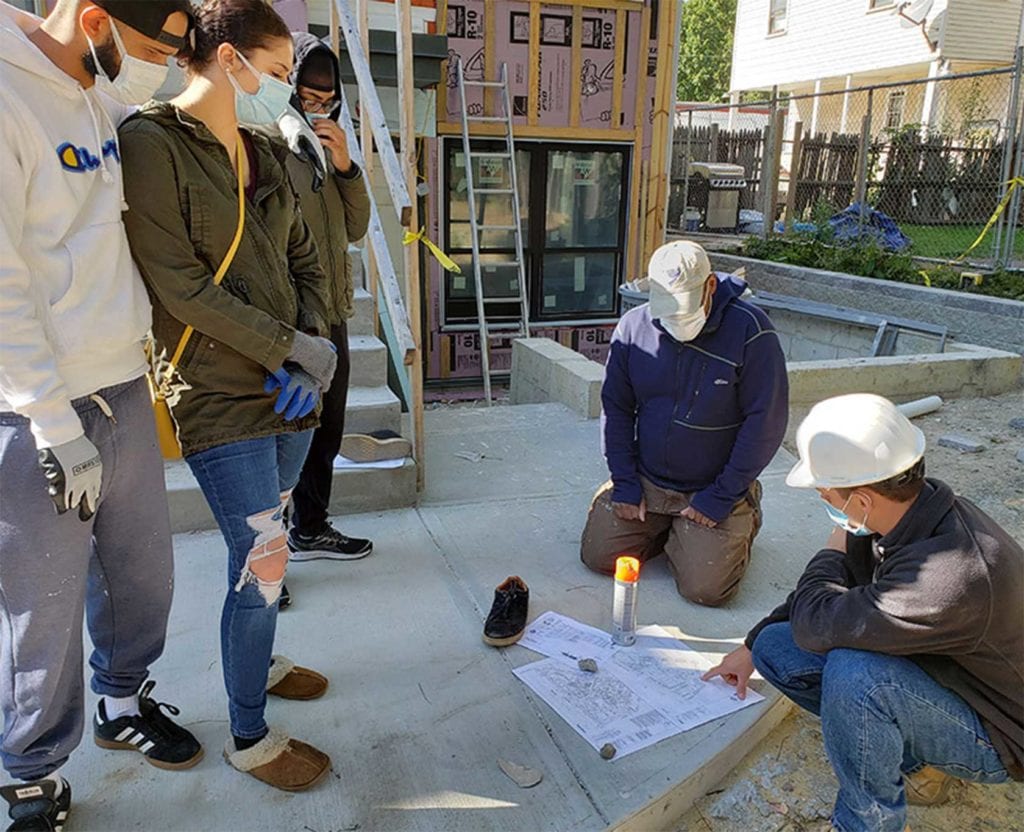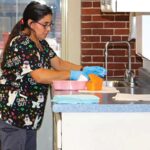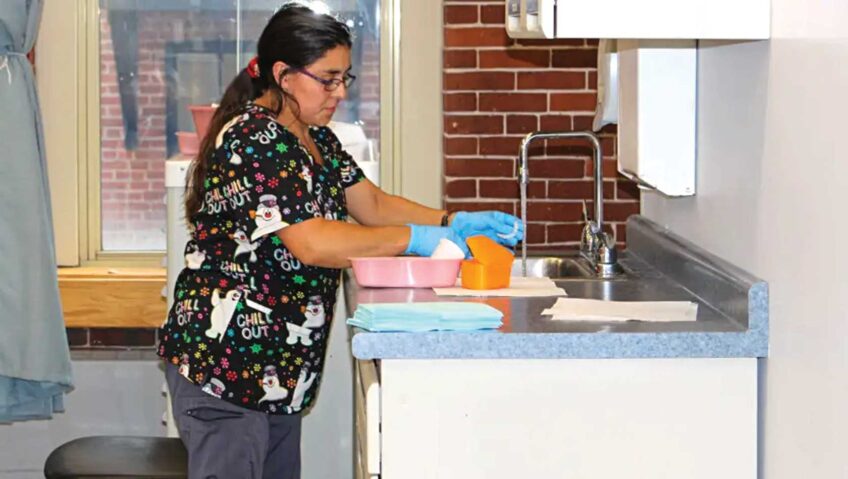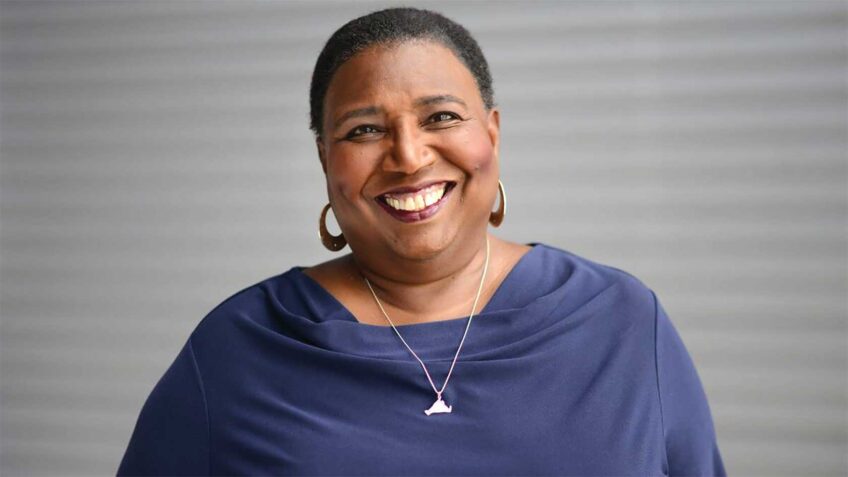
In Codman Square, a cluster of purple perennials and sedges lie low, evenly spaced in concentric rings on the property of a new affordable apartment complex under construction on New England and Mallard Avenues.
Usually, the area around the Talbot Commons I development might flood on a rainy day. But early this fall, Codman Square Neighborhood Development Corporation, the nonprofit that owns the property, invited some local residents to help landscapers plant a rain garden.
“What we’re trying to do is create a job force that is ready to do this work,” said David Queeley, director of the nonprofit’s Eco-Innovation District, which prioritizes environmental sustainability and affordable housing for residents in Codman Square and South Dorchester.
In two outdoor sessions, participants met in socially distanced groups of three, wearing face masks and gloves. It was an opportunity for them to see whether they would be interested in becoming certified in green infrastructure.
“It’s really interesting looking at the plans, looking at the construction site, and then actually … planting the plants, measuring to make sure everything is equidistant and in the right place,” said Beth Griffith, 39, a participant who works as a solar energy advisor in Dorchester. “And it’s amazing to see that these not-so-big plants have a really big job for what they do.”
The durable, water-absorbent vegetation and loose soil underneath can filter and soak up rainwater. Any overflow would be clean by the time it drains into a nearby catch basin, said Queeley.
“You’re in effect emulating natural water cycles to clean stormwater and return it back to the environment in a good way,” said Queeley, who is a certified instructor of green infrastructure. “It’s a lot cheaper to build a green infrastructure facility than it is to build what’s called gray infrastructure, which is pipes, pumps and sewer lines.”
In the coming years, flooding is likely to become more frequent in South Dorchester and other low-lying neighborhoods, like East Boston, West Roxbury, Allston and Brighton, due to more intense storms from a warming climate, according to Boston’s Climate Vulnerability Assessment. But natural systems, like this rain garden, can help prevent flooding in urban areas.
Certification
In late October and early November, eight residents, aged 20 to 60 — some of whom participated in the on-site planting — took a virtual 35-hour training course, taught by Queeley and his colleague Danilo Morales over three weekends, in preparation for the National Green Infrastructure Certification Program’s exam.
The nonprofit offered the course primarily to people of color, who are in the low-to-moderate income range or have experience in trade work, and covered the estimated $700 cost per person through the North American Cities Partnership Fund, a two-year grant that began in 2018 through The Nature Conservancy.
“Being a person of color and having access to this knowledge and certification, that means we’re hopefully closing the economic gap and also providing employment opportunities for people of color. So it means a lot,” said participant Mujihad Muhammad, 37, who is Afro-Caribbean American and a resident of Hyde Park.
Smith Charles, originally from Milton, took the virtual training while in Ithaca, New York, where he is studying at Cornell University and has taken environmental and sustainability engineering courses.
“This type of training is very entry-level into green infrastructure and sustainability, and it’s honestly something that anyone can do,” said Charles, 20, who had heard about the course through his mentor in the Boston area. “I could see a lot of current jobs translating to this because it’s really not that different from a regular landscaping or construction job. It’s just following a different process.”
Muhammad saw the certification as a step toward career advancement.
“I would like to own my construction company someday, but I also have a passion for the green building process,” said Muhammad, who is pursuing a master’s degree in construction management and has experience in residential construction and weatherproofing buildings.
Green infrastructure features are unassuming in the city landscape. They might be green roofs that use vegetation to slow water runoff, or tree trenches – shade trees evenly spaced in absorbent soil pits along a sidewalk. Some parking lots or walkways may have porous pavement, which can let rain seep down to a soil bed underneath. And grassy roadside islands — known as bioswales — help slow traffic and filter stormwater.
“After going through the training, a lot of the green infrastructure — things that are already implemented into our daily lives — just become more and more noticeable,” said Charles. “These structures are not just for aesthetics, and they’re kind of implemented to serve a purpose, which is very neat.”
Removing impervious pavement and greening neighborhoods can also help improve air quality and reduce urban heat — which is especially important for people who can’t afford high energy bills for running cooling systems at home during Boston’s summer heat waves, said Queeley.
Some students took the certification exam on Nov. 7 in a socially distanced classroom setting, while a makeup test will be held for others at a later date, yet to be determined, added Queeley.
Certified individuals can apply to work in construction, maintenance and inspection.
The Massachusetts Clean Energy Center, an economic development quasi-public agency, has a clean energy jobs search engine and a paid internship program — in the fall, spring and summer — for Massachusetts college students, recent graduates or residents who were certified or graduated less than a year ago.
“Dave’s program at Codman Square … especially helps people, who don’t have a lot of education attainment, get to some good jobs that have a lot of growth potential,” said Beverly Craig, senior programs manager of low and moderate income programs at the agency.
This industry could help men of color, particularly those who are reentering the community after being incarcerated, find good-paying jobs, said Queeley.
Griffith said that eventually, she would like to become an instructor.
“I love the green energy field, but I also know that minorities and women are really underrepresented in it,” said Griffith, who is Afro-Latina. “I wanted to get my certification and then get my instructor certification so I could teach other people and help them access employment.”
The Boston Water and Sewer Commission, which manages most of the city’s storm drains and catch basins, has installed some green infrastructure projects already and will likely be building more, as part of the city’s climate goals — a sure sign for new jobs to come.
The Codman Square nonprofit plans to offer another training program in early 2021, though they hope to find more grant sources to fund it.
“We want to make sure people of color are not left out this time, especially now — all the equity issues that have arisen and that are now front and center in our country,” said Queeley. “If we’re not going to do it now, we’re never going to do it.”






